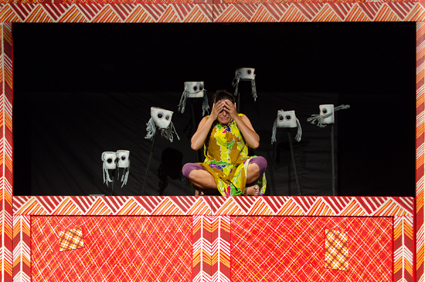Tiwi Island Dreamtime fantasia
Cath McKinnon: Wulamanayuwi and the Seven Pamanui

Dalara Williams, Wulamanayuwi and the Seven Pamanui
photo Lucy Parakhina
Dalara Williams, Wulamanayuwi and the Seven Pamanui
Wulamanayuwi and the Seven Pamanui is a delightfully bonkers theatrical fusion of Tiwi Island Dreamtime stories and characters, pantomime, fairytale, drag, song, puppetry and visual projections.
The narrator, Jarparra the Moon Man (Jason De Santis), introduces us to Wulamanayuwi (Dalara Williams), a young girl and daughter of the Rainbow Serpent totem, who is having trouble at home—her warrior father Jipmarpuwajuwa (Kamahi King) plans to marry her off to a stranger and her evil stepmother, Jirrikalala (performed with gusto and lots of evil cackles by Natasha Wanganeen), is plotting against her.
When Jipmarpuwajuwa goes away he leaves Wulamanayuwi as ‘boss.’ She sets off hunting but instead of arriving at her usual lush hunting grounds she is surprised to find a black and burnt land. Luckily a white cockatoo guides her to bush apples and she returns from the hunt laden with food. Jirrikalala, jealous of the clever daughter, decides to kill Wulamanayuwi and her seven brothers (embodied by seven Tiwi designed puppets) and so seeks counsel from an Evil Spirit of the Water (played with drag queen theatrics by Jason De Santis). The two come up with outrageous and murderous plans. Most don’t work out but one hot day, when the brothers go swimming with their sister, the Water Spirit drowns them. Wulamanayuwi is blamed for their deaths and is exiled from her family and country. Bereft, she journeys to a magical land where she meets the Seven Pamanui spirits (not unlike her drowned little brothers), beings out to seek revenge. Later, she eats food from an old woman (Jirrikalala in disguise) and seemingly dies. Her promised husband Awarrajimi (Jaxon De Santis) turns up, tries to revive her, but can’t. The white cockatoo, however, materialises in time to save Wulamanayuwi.
By the end of the play order is restored to the family and the land. Deftly written by Jason De Santis, ebulliently directed by Eamon Flack, quirkily designed by Bryan Woltjen, with AV by Sam Routledge (who was also the puppetry director), Wulamanayuwi and the Seven Pamanui was performed with zest, a whole lot of cheek and a gleeful sense of anything goes. This is a creative team unafraid of mixing Tiwi Island traditional story with European fairytale convention and pop culture tropes. Tiwi language is mingled with English, colloquial speech with rhyme, ballad singing with traditional Indigenous songs, Mozart and Beethoven. The production is staged around a set of portable proscenium arch frames decorated with crosshatched Tiwi designs. Set painter, Raelene Kerinauia, and painters of the brother puppets, Pedro Wonaeamirri, John Peter Pilakui and Linus Warlapinni, all artists from the Jilmara Arts and Crafts Association in Milikapiti on Melville Island, worked with Bryan Woltjen to realise the design.
The production was commissioned by the Darwin Festival and premiered at Adelaide’s COME OUT Festival in March 2011. It continues to tour Australia. The performance I saw was opened with a welcome to country by local elder Richard Davis and the audience ranged from the very young to the very old. This was a noisy, happy, slightly lunatic theatrical event, an enchanting and cheeky tale—testament to the potential for levity in storytelling and the importance of laughter and song in negotiating life.
Wulamanayuwi and the Seven Pamanui, a Darwin Festival commission, toured by Performing Lines, IPAC, Wollongong, 19-22 March; Cairns 19-20 June, Mackay 24 June, Brisbane 26-29 June
RealTime issue #121 June-July 2014 pg. 36






